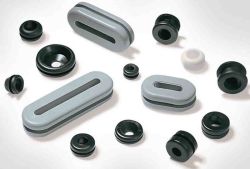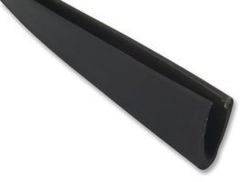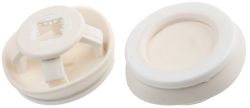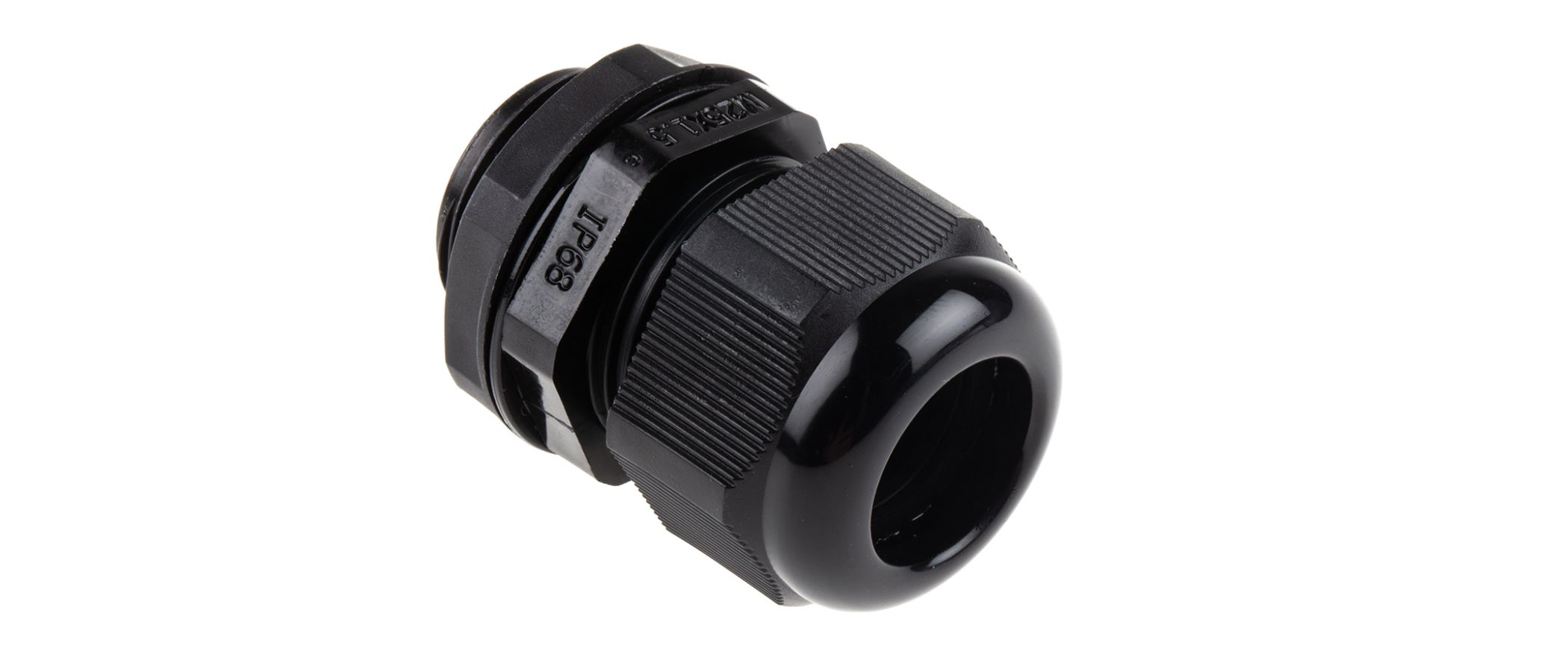A Complete Guide to Rubber Grommets
Our guide focuses on rubber grommets, explaining their uses, the different types, sizes, key brands, and more.

What is a Rubber Grommet?
Let’s start with the basics - just what is a rubber grommet? They are attachments used in electrical engineering and manufacturing to cover sharp edges. This may have functional benefits - for example, ring-shaped grommets help to avoid cuts and friction damage to wires, cables and pipes.
They also provide additional protection against dust and water. Such grommets usually feature flared collars to hold them in place. Alternatively, edge strip rubber grommets may simply provide a more pleasing appearance to the device where they are attached.
They are typically black, but you will also find transparent and grey varieties.
Rubber grommets have several alternative names, including:
-
Edging
-
Eyelets
-
Bushings or insulating bushings, when used with electrical appliances (up to 51 mm in size)
Rubber Grommet Uses
Rubber cable grommets are versatile products that are widely used in several industries. Their principal uses include:
-
Covering the sharp edges of holes in metal plates to protect cables and pipes from cuts and chafing damage, prolonging their useful life. A common example is an electrical backbox. These are rectangular chambers inserted into walls to house plugs and power points, with the wiring entry and exit points protected by grommets
-
Rubber grommets provide strain relief, gripping wiring in place and minimising the damage and disruption that might occur if the cord or cable was accidentally pulled. A good example of this usage is ethernet and other ports at the back of PCs and laptops
-
Reducing engine vibration in cars and other vehicles

Amongst the industries to make routine use of rubber grommets are:
-
Electronics
-
Construction
-
Automotive engineering
-
Aeroplane engineering and avionics
-
Telecommunications
-
Internet data centres
-
Medical equipment manufacturers
Rubber is a resilient substance and offers several benefits in comparison to other grommet materials. It is resistant to:
-
Weather
-
Moisture
-
Heat
-
Low temperatures
-
Ozone
-
Ultraviolet light (UV)
-
Hydrochloric, saltpetre, phosphoric and sulfuric acid
-
Alkali environments
-
Strain
Rubber does not dry out, crack or come loose easily. Rubber grommets do not require screwing, so they can be inserted more easily, and also do not need locking nuts so can be inserted from one side only. Rubber grommets are push-fit, meaning that they are held in place by internal pressure and expansion only and so require no adhesive.
Rubber Grommet Types
Rubber grommets are available in several different types. Here are the principal ones:
Rubber Blanking Plugs
Rubber blanking plugs are used to seal holes and are designed to hold and control pressure coming from above or below, making them a good grommet choice for high-pressure devices and tubing.
Some feature a small hole into which a wire can be inserted for a firm hold. These are called diaphragm grommets.
Open Rubber Grommets
Open rubber grommets are the most basic design, featuring a central hole. They are used to protect cables and pipes when they pass through holes in metal plating.
Closed Rubber Grommets
Also known as blind rubber grommets, closed grommets provide air-tight seals when applied, and can be a good choice for sealing holes not currently in use to prevent the build-up of dust.
Unlike similarly shaped round grommets, blind rubber grommets have no central hole. They are widely used by the electronics industry.
A further variant is the semi-blind grommet. These feature a central membrane that is thin enough to be pierced by wires or cables. This means that semi-blind grommets can take the place of both open and closed grommets.
Rubber Grommet Strips
Rubber grommet strips are distinct from other designs. They are strips designed to sit along the edge of a panel or plate to smooth its edge. They can be cut to size and adhesive varieties are also available.
Tapered Rubber Grommets
Tapered rubber grommets are principally used to blank (seal) holes in metal panels and plates. The tapered design allows them to be used with thicker panels that might be too large for a closed grommet
Stepped Rubber Grommets
Stepped rubber grommets typically have a tapered cone shape, marked at intervals. These lines indicate where the grommet can be cut to different sizes. This versatile design makes them ideal for industries that use multiple cable sizes.
White Rubber Grommets
White rubber grommets are a distinctive variety typically made from silicone. They are resistant to both low and high temperatures (between -55°C and 180°C), while special varieties of silicone resist temperatures as high as 800°C.
Custom Rubber Grommets
Some manufacturers offer custom rubber grommets, also known as special shape grommets, made to a customer’s unique specifications. This can include particular rubber materials, sizes and designs.
Rubber Grommet Shapes
Like most manufactured components, grommets are available in a variety of designs for different tasks. These include:
-
Square rubber grommets
-
Oblong rubber grommets
-
Rectangular rubber cable grommets
-
D-shaped rubber grommets
-
Oval rubber grommets
What are Rubber Grommets Made from?
Most grommets are made from rubber, but plastic grommets are available, along with models made from other materials, including:
-
Polyvinyl chloride (PVC)
Different types of grommet rubber are also used. These include:
Natural Rubber
This offers good tensile strength and resistance to strain and tears, along with strong electrical insulation.
Nitrile Rubber
Also known as Buna-N, nitrile rubber is highly oil-resistant. This makes it the first choice for grommets when exposure to oil is a possibility. Electrically, it is a semiconductor (a substance with electrical conductivity halfway between an insulator and a metal) and is also antistatic.
Fluorocarbon Rubber
Also known as FKM, fluorocarbon rubber is a particularly stable rubber effective that can withstand high temperatures and strongly acid or alkali environments.
Neoprene
This resilient material is resistant to heat, flame, ozone corrosion and weather, making it a good choice for use outdoors and in areas of fire risk.
Silicone
Silicone offers bright colours and it is a friendlier material than some other rubbers. It is odourless and perfectly safe when in contact with food and skin, so silicone grommets are frequently used in kitchen devices, food processing machines and medical equipment.
Rubber Grommet Sizes
Rubber grommets are available in a variety of sizes suited to different tasks. Various metrics can be used to measure grommets but for round grommets, the most fundamental are:
-
The maximum cable diameter - i.e. the largest cable that will pass through the central hole
-
The panel hole diameter - the size of the hole into which the grommet can be inserted
-
The maximum panel thickness - i.e. the depth of the metal plate into which the grommet can be inserted, a measurement which corresponds to its length
The latter metric will vary according to design; larger grommets tend to be shallower.
The following rubber grommet chart lists some of the most common sizes, small to large:
| Maximum Cable Diameter | Panel Hole Diameter | Maximum Panel Thickness |
| 3mm | 6mm | 2mm |
| 4mm | 6.4mm | 2.5mm |
| 6mm | 9mm | 4mm |
| 10mm | 12mm | 2mm |
| 25.5mm (1 inch) | 25.5mm | 2.4mm |
| 31mm | 40mm | 2.5mm |
| 48mm | 60mm | 2.5mm |
Grommet strips are more straightforward. When selecting, simply ensure that they fit the width and breadth of the edge to be covered.
Rubber Grommet Manufacturers
SES Sterling
With a wide range of industrial equipment and components on offer, choose SES Sterling for high-quality, reliable rubber grommets.
RS PRO
Browse and shop rubber grommets from RS Pro, our own in-house brand of top-quality components.
Harting
Shop Harting grommets online with RS Components and discover the most suitable rubber products for your requirements.
HellermannTyton
Leading brand HellermannTyton offers rubber grommets in a wide range of shapes, sizes and styles. Shop online today.



